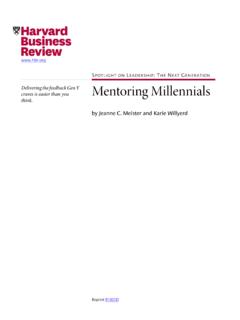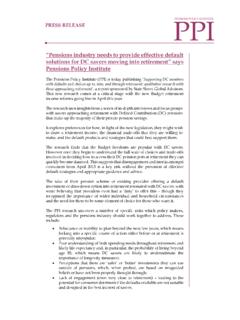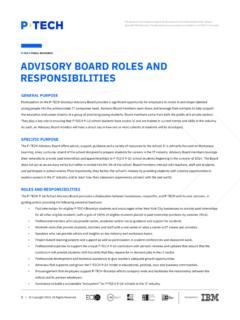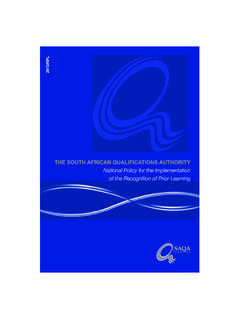Transcription of March 2018 - hse.gov.uk
1 March 2018 HSE Annual Science Review 201802 / 6351 References andfurther readingHSE scientists produce over 100 publications a year. We are committed to making research findings open access accessible online at no cost to the user. We ensure open access to research papers in peer-reviewed journals and journal-like conference proceedings (provided the publisher gives this option) describing research led by our Case studies:Helping Great Britain Work WellTackling ill health: These case studies illustrate how our science is contributing to action to improve health pace with change: A selection of case studies which show how our science is being used to anticipate and tackle new health and safety together.
2 A series of case studies which demonstrate how our science and evidence is being used to promote broader ownership of health and safety in Great risk well: Our science is being used to simplify risk management and help businesses to grow: the case studies in this section show small employers: These case studies demonstrate how we are supporting simple advice for SMEs so they know what they have to our success: The case studies in this strategy theme show how our specialists are using science to promote the benefits of Great Britain s world-class health and safety Events andachievementsHSE Science has hosted a number of important visitors this year.
3 Also, the value of our science expertise has been recognised by others and staff have been presented with various awards and Meet the staffWe employ over 850 scientists, engineers, analysts and medical staff, many hold PhDs or Masters level qualifications and Chartered status within their professional bodies. This section introduces some of our specialist Foreword04 The vitalinterface between HSE science and policy05 HSE s sharedresearchprogramme06 The HSES cience and Evidence Cycle in action: HydrogenContentsHSE Annual Science Review 201803 / 63this review we describe some of the Shared Research now in progress. In addition, the value of our new approach is demonstrated by the pipeline of ideas which includes the handling of metal powder waste from additive manufacturing, the health and safety opportunities resulting from wearable technologies and issues around flammable mists from high flash-point fluids.
4 (Further details can be found at ).Our review provides case studies of work we have delivered for both HSE and external organisations supporting the delivery of the Helping Great Britain Work Well4 s trategy. None of this work would be possible without our science, engineering and evidence experts. Their outputs, their knowledge and their impact on the global scale is evidenced by the record of achievements and accolades highlighted in the review. Their knowledge is not only being used to help Great Britain work well, but increasingly through our international work, they are enabling a healthier and safer working Andrew Curran Chief Scientific Adviser and Director of Researchfor the work that I have taken forward with Clive Fleming, our Head of Policy Profession in HSE.
5 It is critical that the interface between the policymakers and the scientists, engineers and analysts works well, and that evidence and the uncertainty around it is effectively communicated: our joint work has helped share best practice around the can t develop all of our evidence needs on our own, and therefore it is essential that we build effective and long-lasting partnership with other organisations. This year saw the signing of the formal agreement to establish the Thomas Ashton Institute for Risk and Regulatory Research between ourselves and the University of Manchester3. Work is already being delivered which draws on our combined knowledge and experience to deliver research, teaching and regulatory insights to address complex interdisciplinary year, we introduced the idea of Shared Research , where our intention was to open up themes within our Science Hub programmes where other bodies could work with us to fund and develop solutions to problems shared by HSE (as the regulator) and industry.
6 I am pleased that in WELCOME TO OUR third Annual Science Review, which this year has a focus on our work in the field of energy. It complements our new Foresight Review1, which has the same theme. When our research facility was originally established in 1911 by Winston Churchill, its remit was exclusively based on the health and safety risks resulting from a carbon based economy - specifically coal. It s interesting to note that today our work in the energy sector is increasingly about understanding and effectively managing the risks arising in a de-carbonised economy: wind turbines, batteries, nuclear, and the development of a hydrogen gas grid.
7 I m particularly proud of our work on the hydrogen economy where we anticipated the need to understand this area in more detail over 12 years ago. This has enabled us to remain at the cutting edge of this topic, providing practical advice in advance of the use of hydrogen- based technologies to enable their healthy and safe deployment. We also demonstrate how this work exemplifies the science and evidence cycle within our Science and Evidence and how it is applied to underpin our regulatory and policy interventions has been a key driver ForewordHSE Annual Science Review 201804 / 63 The challenge is to ensure we bring these components together to best effect to respond to new risk management and regulatory issues with effective, innovative and proportionate of the articles in this Review relate to new and emerging technologies and the changing world of work, and it is important to understand the risks these may pose and how they can be effectively controlled.
8 Or how they themselves can contribute to improved health and safety in the workplace. Good policy development can support approaches to change that are proportionate, relevant, persuasive, and effective. For example, work described in these pages is: to help understand changing workplace exposures; to provide robust evidence to those negotiating alternatives to unduly prescriptive standards; to THIS ANNUAL SCIENCE Review showcases the high quality of science, evidence and analysis that underpins HSE s risk-based regulatory regime. To be an effective regulator, HSE has to balance its approaches to informing, directing, advising, and enforcing through a variety of activities.
9 For this we need capacity to advance knowledge; to develop and use robust evidence and analysis; to challenge thinking; and to review simple terms, policy provides the route map to tackling issues. HSE is particularly well placed in terms of the three components of effective policy - politics , evidence and delivery . Unlike most regulators and arms-length bodies, HSE leads on policy development, which draws directly on front line delivery expertise and intelligence; and we are also unusual in having our own world class science and insight vital interface between HSE science and policyunderstand how best to influence duty holder behaviors in the changing world of work; to inform possible legislative changes to allow different modes of safe gas transmission; to change administrative processes for Appointed Doctors.
10 And to support our position as a model modern regulator by further focusing our inspection activity where it matters work well together and it is important we maintain this engagement as a conscious Fleming Head of HSE Policy ProfessionHSE Annual Science Review 201805 / 63 This Shared Research programme was developed through consultative workshops with stakeholders from offshore and onshore industry as well as installers of composite repairs. These workshops agreed the key scientific and engineering research questions - both technological, such as experimental mechanical engineering and fire research needs, and human and organisational key aim is to develop agreed good practice for use of engineered composite repairs for safety-related equipment in order to support improvements in safe, reliable and efficient operations.

















